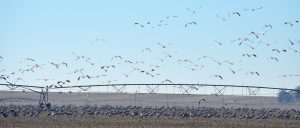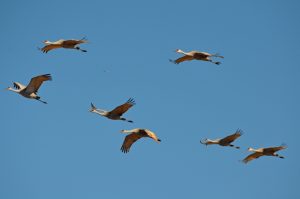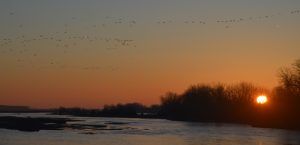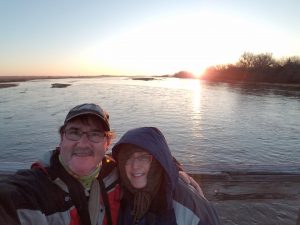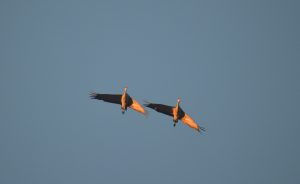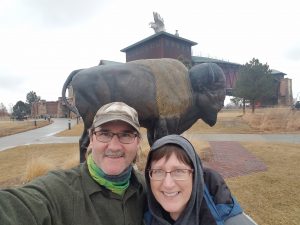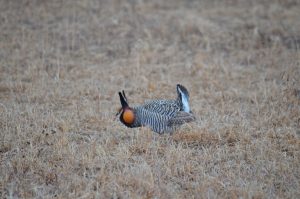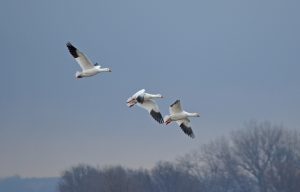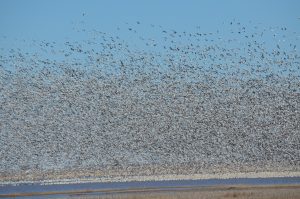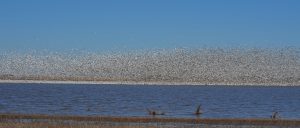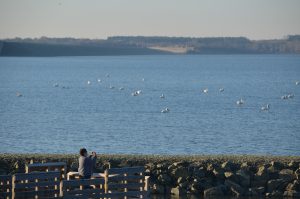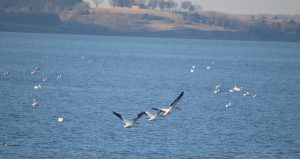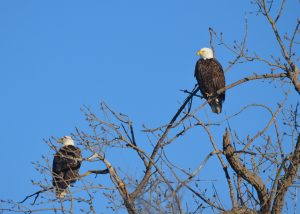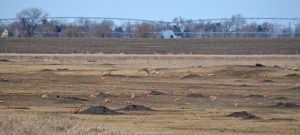It was three days before our departure date when I finally received an email reply back from Audubon’s Rowe Sanctuary, along the Platte River in Central Nebraska. The news was not very encouraging. Although their Nature Center was open, many of the migrating Sandhill cranes had not arrived yet due to the severe weather they had experienced over the last two weeks. To make matters worse, the roads into their site had been severely damaged by recent, historic flooding that covered many rural parts of Eastern Nebraska and parts of Iowa. Heavy rains, combined with rapidly melting snow and ice, ended up being a recipe for disaster. The Platte River, and many other local waterways where the cranes roost each night on their stopover north, had very little sandbars exposed, forcing the birds to hunker down in local fields. Each spring, about 80% of the world’s sandhill crane population rests and fuels up along 70 miles of the Platte River before continuing their northward migration. Our long-planned trip to see one of the last great animal migrations was not looking so good. When it comes to seeing these large numbers of impressive birds, timing is everything! After many emails, phone calls and checking websites, Theresa and I decided to go for it, and drove the 19 hours to Central Nebraska to see whatever cranes showed up by the time we arrived.
Sandhill Cranes have been found as far north as Alaska and Eastern Siberia. In order to reach these destinations, cranes must build up enough energy to complete their long journey and to begin breeding. For the cranes, the Platte River Valley is the most important stopover on this migration. The river provides the perfect spot to rest, and the nearby farmlands and wet meadows offer an abundance of food. Without the energy gained along the Platte, cranes might arrive at their breeding grounds in a weakened condition — where food may be limited until the spring growing season begins. The Platte River region has a variety of habitats that support cranes. The most important is the Platte River itself. The river is very shallow and sandbars dot the channels. It is here the cranes rest at night, gaining protection from predators like coyotes. In the morning, cranes shuffle up and down the river waiting for the sun to pop up over the horizon. As the sun rises, cranes head out to feed and loaf in the surrounding fields.
A chilly morning watching the sun rise over the Platte River, and thousands of Sandhill cranes taking flight.
During the day, cranes “dance” to relieve the stress of migration and strengthen pair bonds. Cranes are very “social” birds and in the evening, congregate in wet meadows before heading back to the river for the night. We made the right choice. By the time we departed after just two days, there were approximately 200,000 Sandhill cranes in the area. They were constantly flying overhead calling their raspy calls, and flocking in just about every cut cornfield and wet meadow in a 20-mile radius. It was amazing to simply stand there and see and hear these beautiful birds gathering all around us!
A quick photo stop of the Sandhill prairies, and my new best buffalo friend…..Nebraska.
As an added bonus, we also booked a viewing tour in the beautiful Sandhills to experience the courtship “dance” of the Greater Prairie Chicken. The males of these funky birds meet at their courtship areas, called Leks, where they “dance” around, squawking and cooing at other males, and challenging each other. All of their antics are for one reason, to attract girlfriends to mate with. We ventured out in the early morning darkness, 30 minutes before sunrise. We arrived quietly at our makeshift blind-a gutted school bus with folding chairs, open windows and no heat. Fortunately, it was a balmy 33 degrees F, and the early morning rain had stopped. We were asked to stay absolutely quiet, and turn off all flashes on our cameras. The birds begin flying in to the Lek just after sunrise and any sudden noises (or flashes from cameras) would scare them away. Several times while sitting in the bus, I did my best not to cough, sneeze or even fart. It was a very cool experience, and at times, pretty funny, to watch these chicken boys strutting their stuff all over the prairie!
After saying goodbye to the cranes and chickens, we wandered a few back roads of south central Nebraska, and stumbled across a flock of Snow Geese that were roosting on a small, shallow lake in a waterfowl refuge. Not just a few Snow Geese, but approximately 200,000-300,000 all in one spot. They were like a huge swarm of insects, lifting off the lake, then settling back down. It was a “snowstorm” of Snow Geese. We stood there shooting video clips and snapping dozens of photos, and we were the only ones there!
Along our journey, we briefly stopped in Marysville, Kansas, nicknamed the black squirrel capital of Kansas. The town loves their black squirrels so much that they have over 20 large decorated statutes located all over town. The black squirrels are actually a color phase of the Eastern Fox Squirrel. We found both running around the town’s park.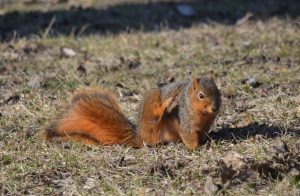
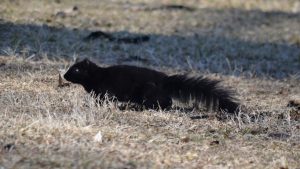

The famous black squirrels (center) of Marysville, KS are a black phase of the Eastern Fox Squirrel (left)….and celebrated with many uniquely decorated statues (right) around town
As our adventure closed, we headed south into Kansas, making one last stop at the Harlan County Reservoir to see hundreds of White Pelicans, dozens of wintering Bald Eagles and a friendly Prairie Dog Town.
A Prairie Dog Town and one of it’s cute little residents.
It was an enjoyable end to our spring fling to the Platte River Valley and prairies of the Great Plains! We saw so much awesome wildlife, beautiful open landscapes and met some great people along the way. If you can go, go!
